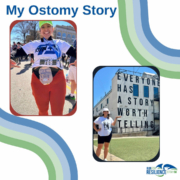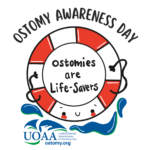Diet and Digestion with an Ostomy
Twelve years ago, Sarah had ileostomy surgery after living for years with ulcerative colitis. Ostomy surgery has allowed Sarah to get back to eating foods she loves, and she says “it has been the best thing for me.”
Sarah now eats many of the same things she did before her ileostomy and enjoys them more than ever. Here are some tips that Sarah has learned over the years for eating, digestion and activity.
- Drink up. Hydration will always be an issue, so drink lots of water. I like to toss in a slice of lemon for a little extra flavor.
- And chew some more. If it looks the same coming out as it did going in, you need to chew those foods better.
- Start slow and build up. If you’re right out of surgery, you might be more sensitive to foods than you will be six months down the road. Use trial and error to see how foods work for you and be sure to track the results. If you’ve had ileostomy surgery, add high-fiber foods back into your diet gradually to make sure you can digest them well. These include raw fruits and veggies (especially with skins), nuts, seeds and popcorn.
- Input always makes output. With an ileostomy, your stoma is going pretty much all the time, so it’s important to track and manage your input and output. For example, if I was going on a job interview, I would not eat a big meal right before, because my stoma may create output and my pouch would fill up – and you don’t want that during an interview!
- Do what you love! I go on bike rides, I go boogie boarding. It may take a little time and tracking to know what works best for your body, but you can do all those things and keep your stoma safe.
Sarah, with the help of the My Ostomy Journey App, now has the ability to track everything digitally. She can also use the app to contact someone for additional support, or if she has any questions.
Sarah says, “The My Ostomy Journey app makes it easy for us to keep track of whether we’ve had enough water or what foods we eat. I wish I’d had this resource right after surgery, especially when I was first figuring out what does and doesn’t work for my body!”
Editor’s note: This blog is from one of our digital sponsors, Convatec. Sponsor support along with donations from readers like you help to maintain our website and the free trusted resources of UOAA, a 501(c)(3) nonprofit organization.













Leave a Reply
Want to join the discussion?Feel free to contribute!